Import planes-Part II
I dismantled the plane after initially rotating it and and tumbling from tote to knob to get my initial feelings and it didn’t feely rattly, loose or anything different than say a new Stanley. In fact it did feel better than a Stanley. Two things stood out visually immediately and perhaps most might not see at first glance. The cutting iron was 3-4mm out of square. Not a big deal but enough to irk me. This then means that the cap iron (chip-breaker USA) couldn’t be set to the 2mm I prefer without shaping that out of square to match. Not a good choice. Issues like this happen with other plane makers and I did have this happen once with a high end plane too.
The sides of the cap iron were slightly out of parallel so whereas one edge to end was square the other was out so I would have to align one edge to the edge of the cutting iron instead of just centring it as I normally do with my fingers either side. Irritating that’s all. Also, it is generally helpful to use the cap iron to confirm squareness to the cutting iron as you unite them. Not a big deal but just my thoughts.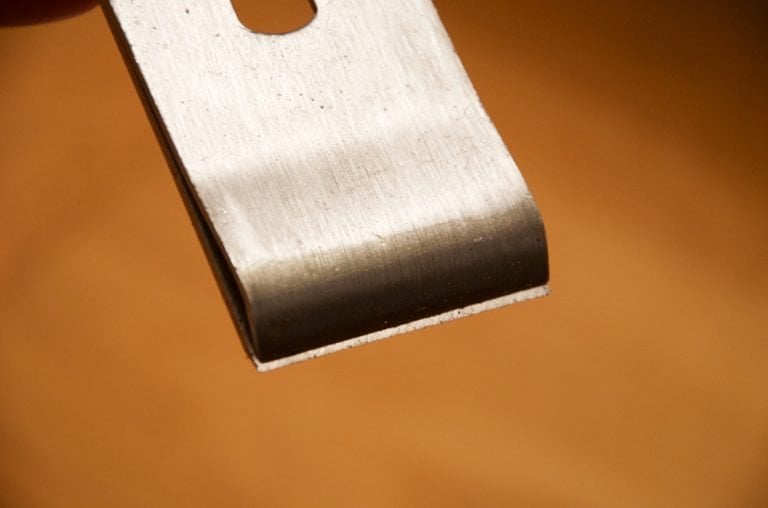
So for me it is worth taking a flat file to the offending side and filing it parallel and straight. A two-second job, that’s all.
The cutting iron is hardened well and takes an edge just fine. To really test it out I must use it for a month or so daily and then throughout the day. It doesn’t take much to make a good plane iron and I am not sure if any plane irons are hammer forged with drop hammers anywhere in the world in general any more. So basically, most of the makers order their steel alloys to a certain recipe and the steel comes in from rolled stock, which they then cut to length, grind, shape and harden. It’s one thing to take an edge and another to hold it keenly. Silly bench tests in magazines are, as with any experiment or test, influenced by some degree by the experimenter and often less accurate than they purport to be as they usually test for hardness alone and rarely distance tested at all.
My first test for hardness is to file the outer edge of the pane iron. Here you can see the change in colour to the edge of the plane iron after I filed it from the cutting edge to the opposite end. The first 1 1/2″ (32mm) barely filed whereas the remainder did file just fine. This shows me that the business end is indeed harder. The iron was just a tad thicker than my Stanley iron from the 60s at 2.06mm whereas the Stanley was 1.86mm.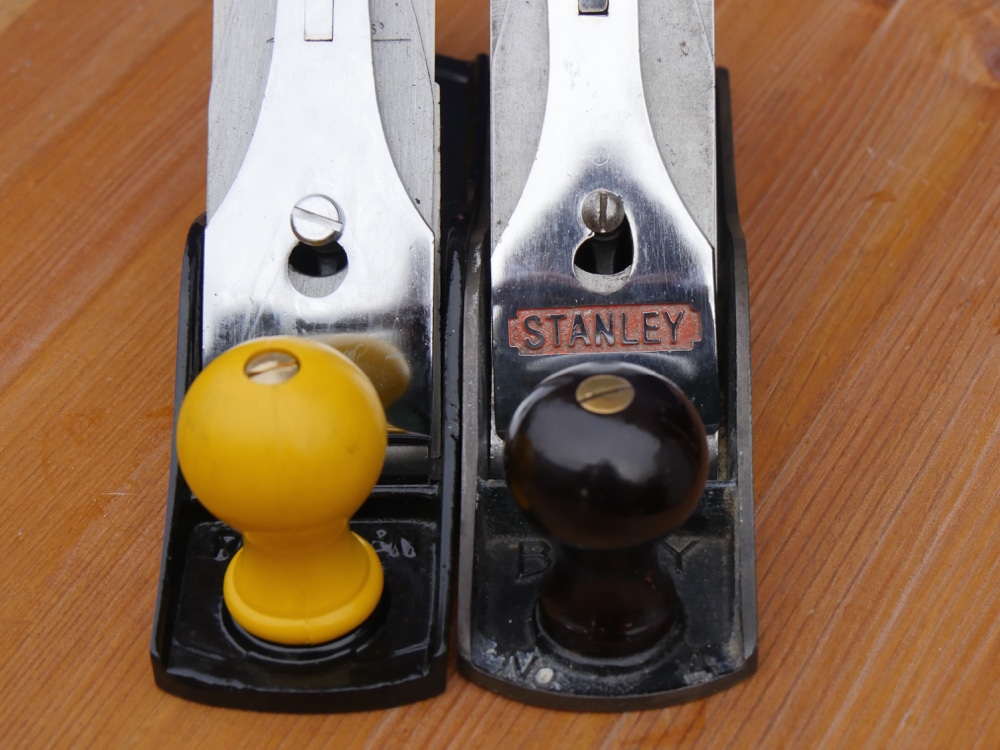
The plane weighed in at 3 1b 13 oz and the Stanley was 3lb 1 oz, which I found interesting, but the nylon handles might be part of the reason for this as they often weigh heavier than wood. Above you can see that the sole is thicker and this too would contribute markedly to the weight difference. 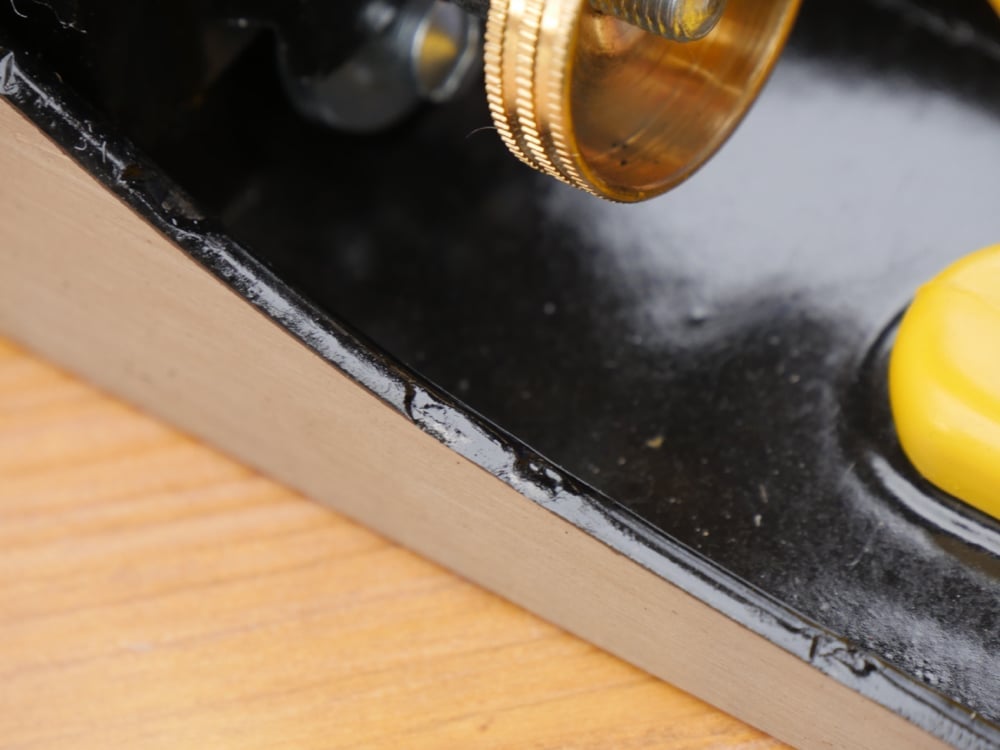
This brass depth adjustment wheel worked just fine and the threads were really quite smooth all told. The split yoke just above worked fine too.
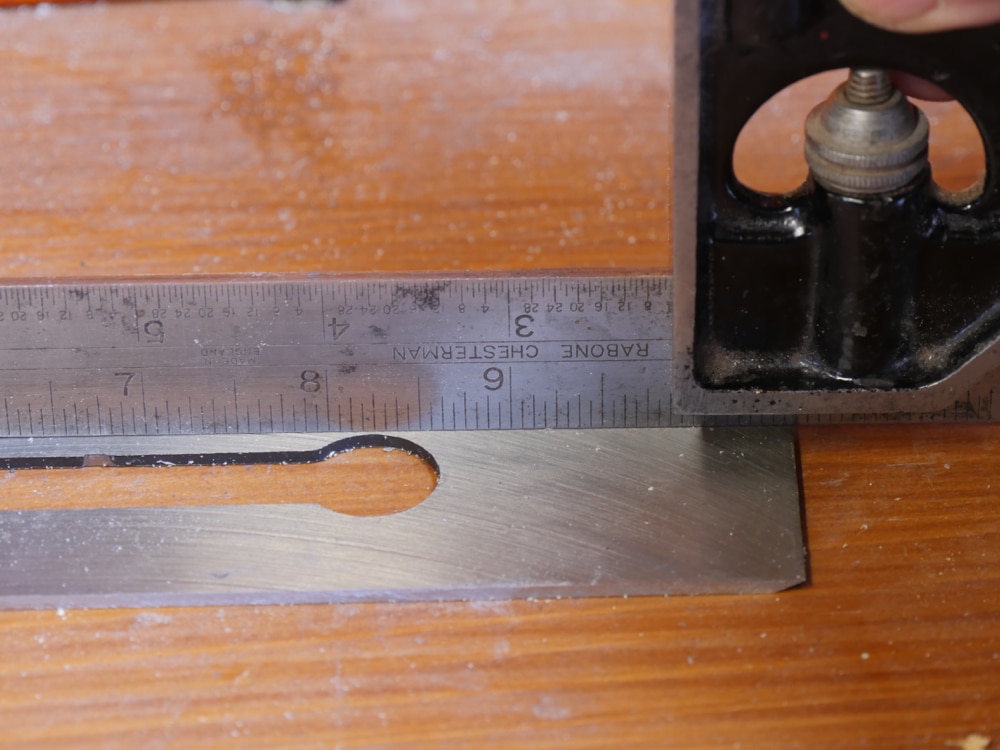
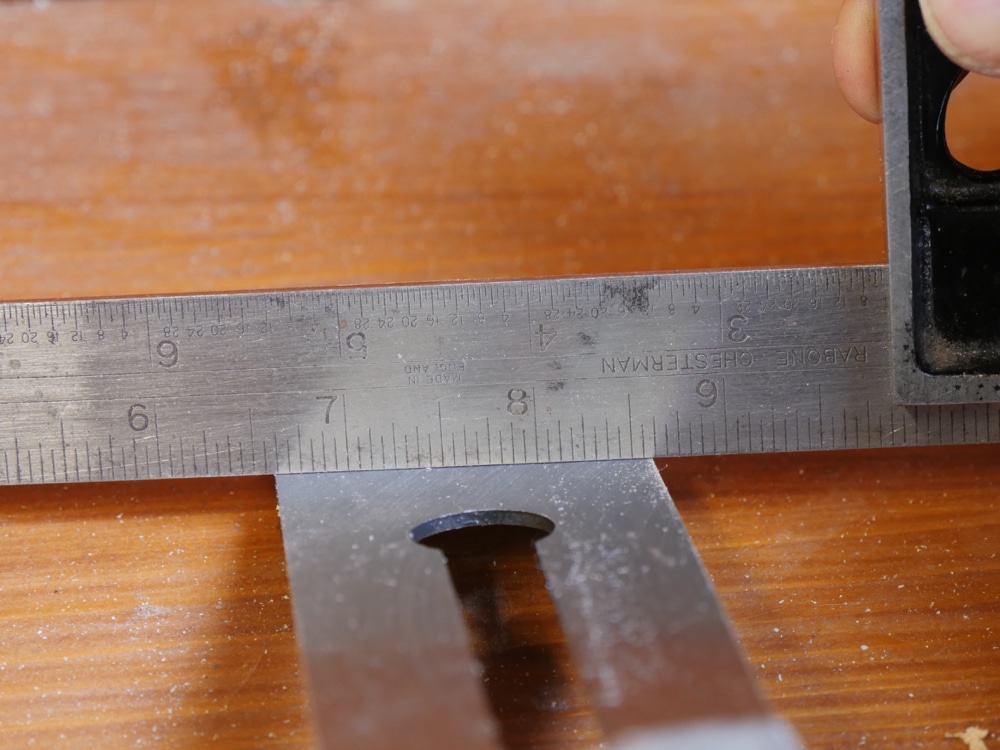


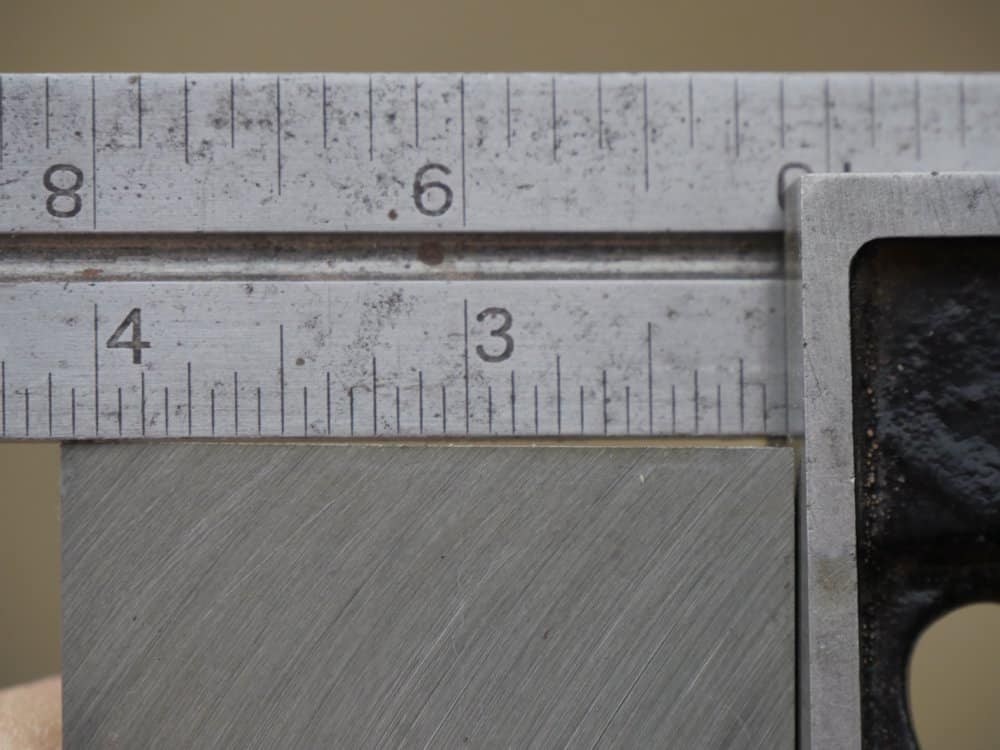
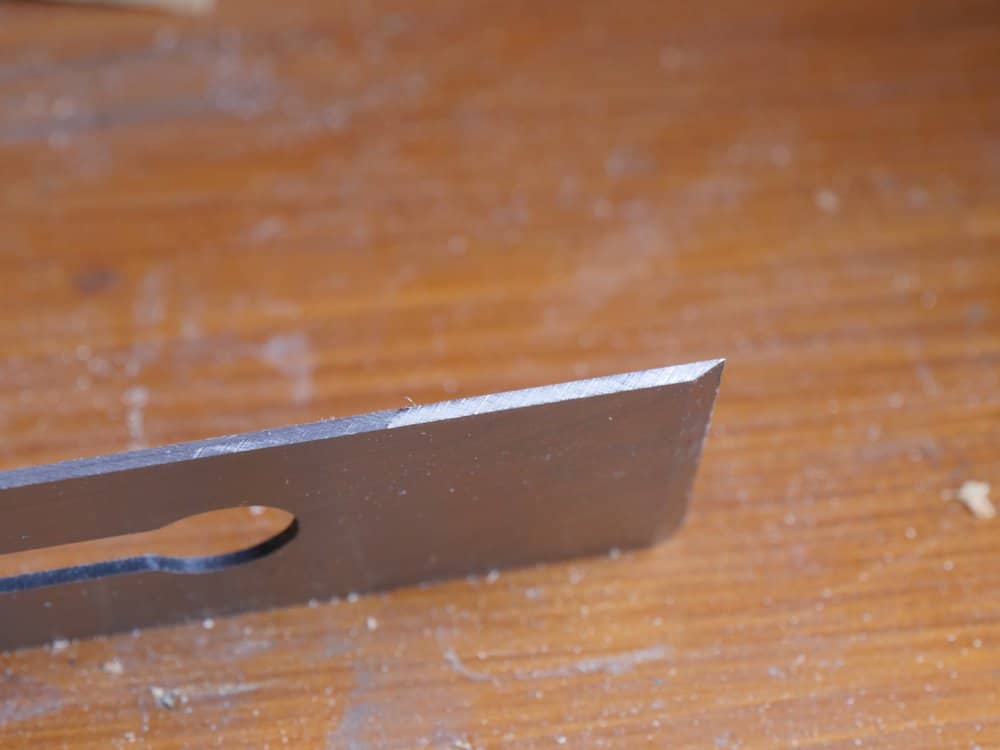
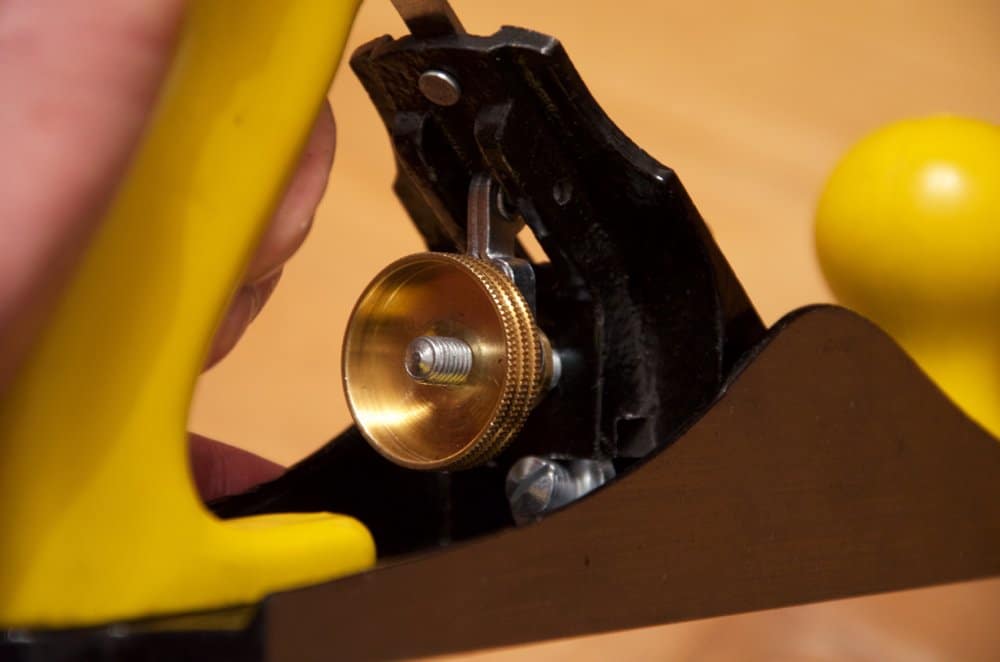
I can’t take the suspense!!
Question: my low angle jack plane (modern stanley) appears to have an out of square iron…the cutting edge isn’t square to the sides. I haven’t tested if the sides are parallel yet though, and will do that tonight.
What is the best way to go about fixing this? It’s only just out of square, so I would expect just a good long honing with a guide would return it to square, but so far has not helped (at 600 and 1200 grit). Thanks for the guidance 🙂
I wouldn’t worry if no more than 1mm generally so when I start to drift I just press ten strokes harder on the offending side and then check. Most plane irons are parallel and this one is parallel, it’s the cap iron that’s out. The lateral adjuster was developed to tolerate a mill or two out of square.
Brad, using coarser grit speeds things up. I lived with a 1-2 mm discrepancy on my old #3 plane for a few years but I recently corrected it. I opted to use my cheap (<£5) set of coarse diamond plates (#100,220,400), rather than my powered wet wheel: fast but controlled. That left the blade sharp, so that it just needed a few strokes on the oil stones* & strop to bring it back to a refined, polished edge and mirror-like bevel.
*My oil stones are roughly equivalent to your 600 & 1200 grit paper.
BTW You may not need 1200 grit paper. A way to eke the most out of your paper: papers lose coarseness with use and gradually become finer, so I tend to use 600 grit paper and when worn use it for my next stage (~1200 grit) and add a new piece of 600 grit for my initial stage (a tip from knife-maker Ben Orford). This approach, followed by stropping works very well.
Excuse my suspicious nature Paul, but when was the last time you checked your square with a traceable square (or at least a reputable engineers square). It does look rather well used?
It is checked at least four times a year and it has been dead square for 51 years to date. How ’bout that. If there is one, just one thing that I know it’s this. I cannot live and cannot work without a dead square square.
Fairy nuff. Sorry – no insult intended, just an engineers suspicions (your square is a bit battered).
No offense taken at all. It is battered an scarred as is its owner.
You might think that – I couldn’t possibly comment 🙂
Hi Paul, I’ve had a lot of problems with so called “squares” which I hope has now been resolved with the purchase of a Stanley Rabone square, which seems to be made to a higher standard than the cheaper versions I’ve been using.
To check for squareness I used the square on a board with a straight edge and drew a line across the board, then reversed the square to check it aligned with the previously drawn line.
Is that a reasonable way to do it? How you check your square is square?
I think you can fix them by gently abrading the little nubs inside the stock that the beam sits on to true it up.
It is very reasonable. For greater accuracy I use a knife on thicker card stock which is as near a perfect edge as you can get. The longer edge of say A4 or Legal depending on continents will take the stock of a combination square. The knife marks need only cu the extremes. Lay the card on a firm support like a section of plywood. This works great. I have access to three or four Starrett 12″ inch squares and also a couple of Browne and Sharpes too so if I am ever in doubt I can always check with these also.
Thanks Paul. I’ll give that a try.
3.13 oz sound implausibly light!
“Implausibly light!”? Not sure what that means. Do you mean the weight is wrong? I checked it thoroughly. Perhaps I fabricated the weight or am mistaken? It’s quite close to a weightier Lie Nielsen ductile iron one at 4lb so I was a little surprised it was so heavy. They also make one with bronze parts that weighs 4.5 lbs so unsure what you are struggling with here, Paul.
I imagine the confusion comes from the “oz”.
3.13oz is right about a fifth of a pound. (0.19 lbs)
Did you mean 3.13 lbs?
Ah, I just assumed everyone would read it as 3lbs 13 ounces
This got me too…I was wondering how a plane could be lighter than a pinewood derby car 🙂 but then realized it reading again.
Paul, I’m sure with your skill and knowledge you could get a plane made from chocolate to work well. An interesting test would be to set up the plane using just the instructions that come with it as that is what most people would do and then to see how it could be improved with all the refining you are demonstrating.
My greatest found flaw unbelievably is that it comes with absolutely no instructions, cautions or safety advice.
Most likely because the people making them don’t know the tools themselves.
Paul – You should buy stock before you give the tool your final endorsement. It seems your say-so carries a lot of weight out here in the world of woodworking with computers and eBay (as opposed to working with actual tools). I just saw a YouTube woodworker bragging about using your marking knife to open a cardboard box! I must be spending too much time at the laptop and not enough time at the bench top.
Re: Instructions
Can confirm: Haha, young people don’t read instructions anyway! But seriously,there is the issue of manufacturing for global markets (in the global pursuit of the cheapest possible cost).
Some observations: Any instruction booklet would have to be translated into so many languages (for each intended market) that it would require dozens or hundreds of pages. Which is mostly wasteful, since people tend to just google it on their phone for a video (when they need help) and toss the expensive to produce booklet into the trash anyway. I notice that some manufacturers try to get around this issue with cartoon image instructions ( no words- just symbols) and maybe a URL to the company website for language specific instructions. Maybe this is a more environmentally sensitive way to distribute the information? It does assume that the buyer has access to internet I suppose, but I do understand why manufacturers hesitate to produce instruction booklets. Besides, when brief instructions are provided, it seems as though some manufacturers use online translators, resulting in some very (unintentionally) humorous instructions (there’s a funny website that documents these)!
One more thought: Almost Everyone in the ‘online outrage business’ blames manufacturers for poor quality, but manufacturers are only providing what consumers are willing to purchase at a price they are willing to pay.
Whereas I may agree with some of what you say, this should not excuse a UK company buying in a product with their name on it, purely for a UK market they own, and accepting responsibility for giving some very basic information. They have no need to give any more than an English information booklet to reach at the very least half the world that actually does speak English to some level. If you bought a camera or a printer, perhaps a dishwasher and even a digital radio you would expect instructions on usage. Why is this different?
I think a single sheet of information on the reverse of the maker’s name sheet could handle this so I don’t think we can be quite so dismissive here.
When you think how many steps go into making one of these planes (rent on factory and utilities, rough casting of body, grinding, bore and tapping of body, fab and refine iron and cap iron, small part manufacture or purchase, assembly, painting, shipping, mark up at sale and overhead at seller) it is unbelievable that one can be sold for 15 to 20 dollars. Refined, smoothed edges? Edges parallel or square? It’s amazing there are edges at all!! Everything Paul is examining and saying needs to be examined and said to confirm that this metal object can be a functioning tool, but when I keep perspective that some place or another there are real people making these, it is amazing that these things exist at all. They must cut so many corners to hit this price point, the question is whether they make a fatal mistake at some point that yields a tool that cannot be brought into service with common hand tools like files. For yucks, just to get a feeling for costs, I looked at MSC’s web site and see that 7 inches of 3/32 O1 tool steel taken from a 36″ bar at 2″ width is almost $8.5
I think I am quite satisfied that this plane will be ready to go so. Actually, I corrected two issues today and then took shavings I felt were adequate for most work.
Also, Ed. It is not really a valid comparison to use MSC with the Chinese’ now unwanted stockpile of excess steel. Not quite apples for apples.I would think that with MSC likely to be at best one the highest priced steel stockists in the US and then China being the lowest we could be looking at a few pennies per inch here. Economies shift by the minute because of the stupidity in globalism and the pursuit of the cheapest goods. I think the answer is to buy local but when the local or homegrown becomes disingenuous enough to buy in cheap goods to label under their own brand name where should our loyalties lie?
Then too you do have issues where domestic product standards drop so badly that the imports become better models whether the price is lower or not. These are difficult issues but good domestic products deserve loyal support. I see other issues too where a US maker exports to the UK and then the Uk maker ships the same product to the US. Prices in both directions become highly inflated. Most British and European makers would not be in business were it not for the US market. I think this is a remarkable phenomenon.
Okay, guilty as charged for the MSC comparison. I agree, but I still have a sense that it is amazing that anything can be produced at this price point.
It’s true. I feel the same way and, frankly, I am surprised in what I am seeing. Someone commented that I was putting a lot of time into this work, asking was it really worth it, but tracking the problems and doing the work is so far about 10 minutes of my time and the plane is actually functioning at a level I might get from a high end plane. All I really need to do now is ease the hard corners, feather-bevel in the soles, things I had to do with Nielsen, Veritas and Clifton versions of the #4 planes recently, as I bought these planes too to test them out in a comparison I was doing, and I will be done.
Of course in no way am I saying this plane is of the same calibre as these top quality planes. I am not and never would. Just that as an entry level there would likely be no compromise in the quality of work you can get from a £10 plane if that is a need for someone.
Thank you for doing this and documenting it, which will help a lot of people. A furniture maker I know uses a number of cheap tools. He finds that for any given cheap tool from his supplier, 1 in 3 or 5 (don’t know the real number) won’t be useable. If he can exchange the dud, he does, but even if he has to trash it and buy another box of the exact same tool, he finds he comes out ahead. I could see that happening with these planes, but even so you’ll come out ahead and have some spare parts. I must say that I feel some sense of unease by wanting to one day sell my work for a fair price while, on the other hand, being attracted to these tools that undersell dedicated tool craftsman and may not pay workers fair wages. I guess if the seller is willing to offer at this price, in some sense it is a fair price and that is the reality of the market. Still, worrisome.
It is globalisation that is worrying because politicians and economists manipulate the populace by incomplete conclusions that manifest in false assumptions worldwide. At one time I saw the Japanese and Chinese mocked for producing such low quality goods. I remember someone saying of you buy a Chinese violin it will sound like a Chinese violin. In those days they did. Not so today. The bar was raised from within their ranks and they met and then surpassed anything Stanley of Sheffield could make. They, as did many others, domestic and foreign, copied the general invention of Leonard Bailey and Stanley and made the better model as well as the lesser model. Without a US market the Chinese models would not exist. So, did Woodcraft and others unleash a competition against its own economy as happens here in the UK and Europe?